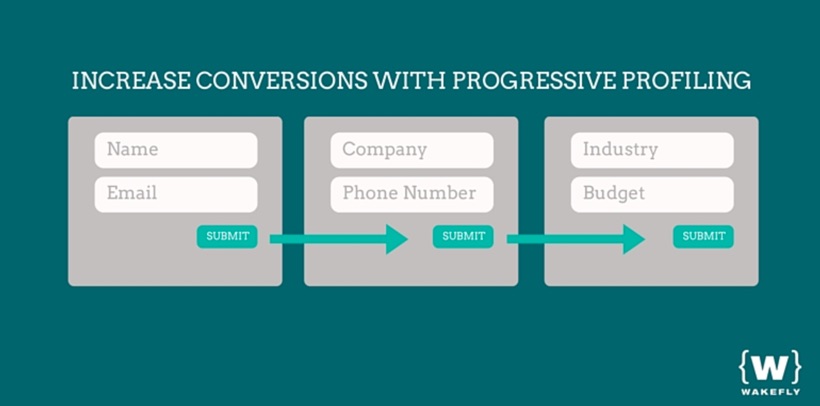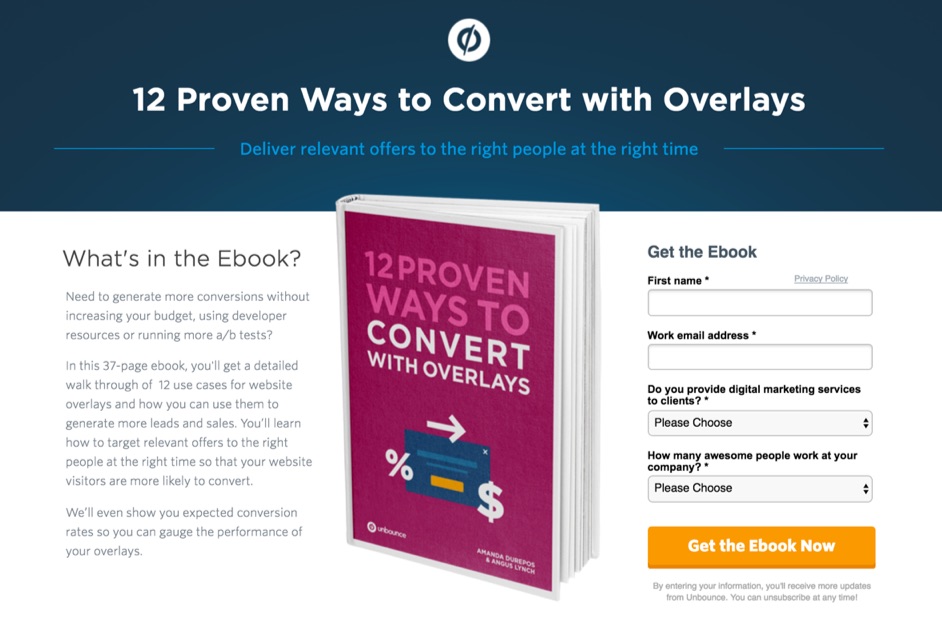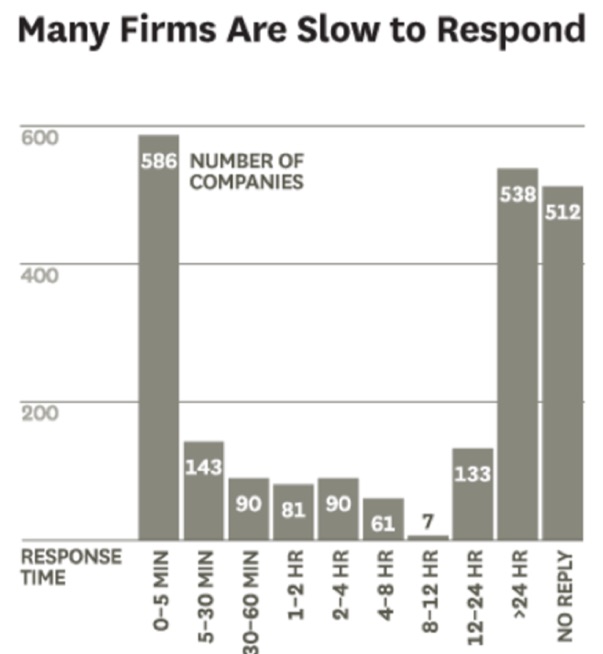Market2Lead reports that “nurtured leads experience a 23% shorter sales cycle.”
By building an active relationship with buyers, your team is equipped to guide people through the sales journey. An engaged seller can anticipate consumer needs and customize the overall experience.
“With the ability to create and apply customer data assets, it’s possible now to marry the content, advertising and marketing offers into a personalized journey that is relevant to each individual user rather than just large blocks of user demographics,” says Tom Wilde, chief product officer at Cxense.
Integrate data into your lead nurturing campaigns. Let’s explore a few techniques below.
Progressive Profiling
The process of collecting data plays an integral role in lead nurturing. You can’t gain every piece of consumer information in one interaction.
We live in a world where personal details aren’t dished out by consumers easily. People must trust your brand and know you won’t sell their data to third parties.
Of course, social proof is one way to earn consumer trust. You can post security badges and publish guarantee statements to reassure the shopper.
Another way to gain the shopper’s confidence is with progressive profiling. It’s a “lead acquisition technique that involves requesting one or two pieces of information at a time, starting with basic firmographics (e.g. company size, job title, industry) and leading into deeper, more targeted questions later in the relationship.”
Progressive profiling eases your brand into a relationship with the consumer. Similar to a first date, where you wouldn’t ask for the person’s entire life history, this tactic slowly gets consumers comfortable with releasing information.

In this example, the visitor first fills out name and email to submit. The next time they fill out the form, those fields (name and email) are filled and two additional fields, Company and Phone Number are added so the visitor fills those in.
For B2B brands, ask prospects for their name and email initially. Then, request for their company’s name and phone number. After that, you may want to know their business industry and budget.
This less intrusive approach alleviates the friction in the lead nurturing campaign. Instead of hesitating to enter details, buyers are more willing to give some information right now.
“Short and sweet produces the best results when it comes to form conversion. So by reducing the number of fields with progressive profiling from 7 to, say, 3, you reduce the pain and increase the conversion rate,” states Bob Ruffolo, founder and CEO of IMPACT.
Experiment with progressive profiling in your campaigns. The more data you gather, the better you can serve your customers.
Tailoring Communication
As your team begins to contact leads, you must know which particular phrases and expressions connect with your audience. Tailoring your communication offers an opportunity to speak directly to the individual.
What you say to your buyers matters. It’s not enough to talk about certain product features or attempt to impress them with industry jargon.
People want authenticity that presents itself in their language. And that language determines whether they continue to stay engaged.
Discover words that connect to buyers by monitoring sales conversations and observing in-person nonverbal cues. Each interaction empowers your team to walk in the shoes of the consumer.
“Collect data at every point of interaction, get to know your customer and focus on how you can help deliver more value. This open feedback loop will create happier customers and ultimately, a better product,” writes Denise Chan, content marketing manager at Mailjet.
Communication centers around what your team brings to the dialogue, too. It’s perfectly acceptable to listen and learn from your consumers, but you also need to add value to their lives.
That valuable offer is usually something that will motivate them to take an interest in your brand. It will build trust and establish a stronger relationship.
Unbounce indulges its prospects with case-filled ebooks that provide solutions to their most pressing needs.
Communication is vital to mastering your nurturing campaigns. Personalization adds to the customer experience.
Know When to Engage
Customer data helps companies shape the lead nurturing process and adapt to buyers’ behaviors and desires. Knowing when, where, and how to interact with consumers gives your team a competitive edge.
By examining behavioral data, your sales teams can discover the best times to conduct outreach calls and send emails. You must accommodate for time zone differences, national holidays, and cultural expectations.
Hubspot reports that “the odds of a lead entering the sales process, or becoming qualified, are 21 times greater when contacted within five minutes versus 30 minutes after an inbound lead converts on your website.”
However, most companies fail to respond to leads in a timely fashion. Research revealed that 42 hours is the average response time among U.S. companies that responded within 30 days.
Remember that lead nurturing is an ongoing process. So, avoid rushing the lead to the next stage. And encourage your sales team to work together to help prospects. A buyer may be more receptive to a specific representative, or a particular deal may involve a special skill set.
Even with the competitive nature of hitting sales goals, your staff must focus on satisfying the consumer.
“The best piece of advice for lead nurturing that you can follow is to establish realistic expectations early on in the process. Let people know that this is a team effort and that there’s not going to be an immediate windfall of sales opportunities at the beginning,” says John Shea, a sales leader and strategist.
Use data to learn when to approach your prospects. The timing is just as important as what you communicate.
Matching Purchasing Intent to Solutions
What problem is the buyer trying to solve? With customer data, your team can match the buyer’s purchasing intentions to your product solutions.
The University of South Australia found that the timeliness and quality of information combined with trustworthiness have a positive influence on information usefulness, which helps predict consumer purchase intention.
Sometimes, the best option for uncovering intent isn’t by directly talking to consumers. You may need to monitor online communities where buyers express their honest opinions to their friends and family members.
Social media is a good starting point. Search for specific keywords related to your product or sift through direct mentions from your consumers. Invest in a social media listening tool, like HootSuite, to help with this research.
In the tweet below, a customer asks Zendesk if the business plans to offer an Apple Watch app. For this customer service software company, these requests may lead to new services for consumers.
@danburdi No plans yet, but we'll post about it for sure! :) Please follow this link for Zendesk updates: https://t.co/tXEQXabxbQ
— Zendesk (@Zendesk) November 26, 2016
Figure out what intrigues buyers about your product. With multi-use services, it’s essential to learn how people benefit. You may be surprised to learn that consumers have found a different way to gain value.
“Understanding consumer intent and meeting their needs in the moment are the keys to winning more hearts, minds, and dollars…the brands that understand and respond to intent are better positioned to be there and be useful for all of their potential customers, not just those that fit an age and gender profile,” states Lisa Gevelber, vice president of marketing at Google.
Understanding consumer purchasing intent helps guide your interactions with the buyer. Be ready to offer a solution to clinch the sale.
Lead Nurturing With Data
Move your prospects down the sales funnel. Merge data into your lead nurturing strategy for higher conversions.
Use progressive profiling to learn more about your buyers. Tailor communication to sell the benefits of your products. Decide the best time to initiate engagement. And continue to understand why people use your services.
Guide your lead nurturing campaigns with data at the forefront.
About the Author: Shayla Price lives at the intersection of digital marketing, technology and social responsibility. Connect with her on Twitter @shaylaprice.
from The Kissmetrics Marketing Blog https://blog.kissmetrics.com/streamline-lead-nurturing/


No comments:
Post a Comment